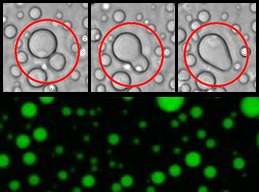A newly identified complex of Tau and RNA suggests a path to aggregation

The hallmark of many neurodegenerative diseases is the formation of protein aggregates, yet how and why these aggregates form remains a mystery. In a study publishing 6 July in the open access journal PLOS Biology by the laboratories of Songi Han and Kenneth S. Kosik at the University of California Santa Barbara, the authors identify a novel property of tau, the aggregation-prone protein associated with Alzheimer's disease, which may reveal a new step in the formation of pathological tau aggregates.
The authors show that tau protein can condense into a highly compact "droplet" - known as a complex coacervates - in a complex with RNA while retaining its liquid properties. Tau and RNA are held together in phase separation from the surrounding environment, and despite the high concentration, the tau protein initially avoids assembling into fibers. However, this novel state creates a set of conditions in which tau becomes vulnerable to aggregation.
Depending on the length and shape of the RNA, increasing numbers of tau molecules can loosely associate with the complex. These properties have been observed with several other neurodegenerative disease-related proteins, such as those that cause amyotrophic lateral sclerosis. The findings provide a biophysical clue on the path to understanding tau pathology. Critical steps along this path include the intrinsic ability of tau to fold into a myriad of shapes, its ability to bind to RNA, and its ability to form compact reversible structures under physiologic conditions.
Future research is required to identify the counterpart of tau droplets in living cells, and to determine how and why a cell regulates the formation and dissolution of these droplets, insights that could lead to potential therapies.
More information: Zhang X, Lin Y, Eschmannc NA, Zhou H, Rauch J, Hernandez I, et al. (2017) RNA stores tau reversibly in complex coacervates. PLoS Biol 15(7): e2002183. doi.org/10.1371/journal.pbio.2002183

















